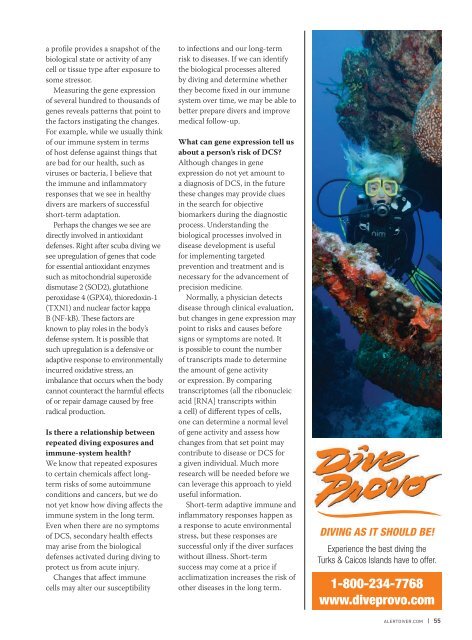AD 2017 Q1
Alert Diver is the dive industry’s leading publication. Featuring DAN’s core content of dive safety, research, education and medical information, each issue is a must-read reference, archived and shared by passionate scuba enthusiasts. In addition, Alert Diver showcases fascinating dive destinations and marine environmental topics through images from the world’s greatest underwater photographers and stories from the most experienced and eloquent dive journalists in the business.
Alert Diver is the dive industry’s leading publication. Featuring DAN’s core content of dive safety, research, education and medical information, each issue is a must-read reference, archived and shared by passionate scuba enthusiasts. In addition, Alert Diver showcases fascinating dive destinations and marine environmental topics through images from the world’s greatest underwater photographers and stories from the most experienced and eloquent dive journalists in the business.
Create successful ePaper yourself
Turn your PDF publications into a flip-book with our unique Google optimized e-Paper software.
a profile provides a snapshot of the<br />
biological state or activity of any<br />
cell or tissue type after exposure to<br />
some stressor.<br />
Measuring the gene expression<br />
of several hundred to thousands of<br />
genes reveals patterns that point to<br />
the factors instigating the changes.<br />
For example, while we usually think<br />
of our immune system in terms<br />
of host defense against things that<br />
are bad for our health, such as<br />
viruses or bacteria, I believe that<br />
the immune and inflammatory<br />
responses that we see in healthy<br />
divers are markers of successful<br />
short-term adaptation.<br />
Perhaps the changes we see are<br />
directly involved in antioxidant<br />
defenses. Right after scuba diving we<br />
see upregulation of genes that code<br />
for essential antioxidant enzymes<br />
such as mitochondrial superoxide<br />
dismutase 2 (SOD2), glutathione<br />
peroxidase 4 (GPX4), thioredoxin-1<br />
(TXN1) and nuclear factor kappa<br />
B (NF-kB). These factors are<br />
known to play roles in the body’s<br />
defense system. It is possible that<br />
such upregulation is a defensive or<br />
adaptive response to environmentally<br />
incurred oxidative stress, an<br />
imbalance that occurs when the body<br />
cannot counteract the harmful effects<br />
of or repair damage caused by free<br />
radical production.<br />
Is there a relationship between<br />
repeated diving exposures and<br />
immune-system health?<br />
We know that repeated exposures<br />
to certain chemicals affect longterm<br />
risks of some autoimmune<br />
conditions and cancers, but we do<br />
not yet know how diving affects the<br />
immune system in the long term.<br />
Even when there are no symptoms<br />
of DCS, secondary health effects<br />
may arise from the biological<br />
defenses activated during diving to<br />
protect us from acute injury.<br />
Changes that affect immune<br />
cells may alter our susceptibility<br />
to infections and our long-term<br />
risk to diseases. If we can identify<br />
the biological processes altered<br />
by diving and determine whether<br />
they become fixed in our immune<br />
system over time, we may be able to<br />
better prepare divers and improve<br />
medical follow-up.<br />
What can gene expression tell us<br />
about a person’s risk of DCS?<br />
Although changes in gene<br />
expression do not yet amount to<br />
a diagnosis of DCS, in the future<br />
these changes may provide clues<br />
in the search for objective<br />
biomarkers during the diagnostic<br />
process. Understanding the<br />
biological processes involved in<br />
disease development is useful<br />
for implementing targeted<br />
prevention and treatment and is<br />
necessary for the advancement of<br />
precision medicine.<br />
Normally, a physician detects<br />
disease through clinical evaluation,<br />
but changes in gene expression may<br />
point to risks and causes before<br />
signs or symptoms are noted. It<br />
is possible to count the number<br />
of transcripts made to determine<br />
the amount of gene activity<br />
or expression. By comparing<br />
transcriptomes (all the ribonucleic<br />
acid [RNA] transcripts within<br />
a cell) of different types of cells,<br />
one can determine a normal level<br />
of gene activity and assess how<br />
changes from that set point may<br />
contribute to disease or DCS for<br />
a given individual. Much more<br />
research will be needed before we<br />
can leverage this approach to yield<br />
useful information.<br />
Short-term adaptive immune and<br />
inflammatory responses happen as<br />
a response to acute environmental<br />
stress, but these responses are<br />
successful only if the diver surfaces<br />
without illness. Short-term<br />
success may come at a price if<br />
acclimatization increases the risk of<br />
other diseases in the long term.<br />
DIVING AS IT SHOULD BE!<br />
Experience the best diving the<br />
Turks & Caicos Islands have to offer.<br />
1-800-234-7768<br />
www.diveprovo.com<br />
ALERTDIVER.COM | 55









